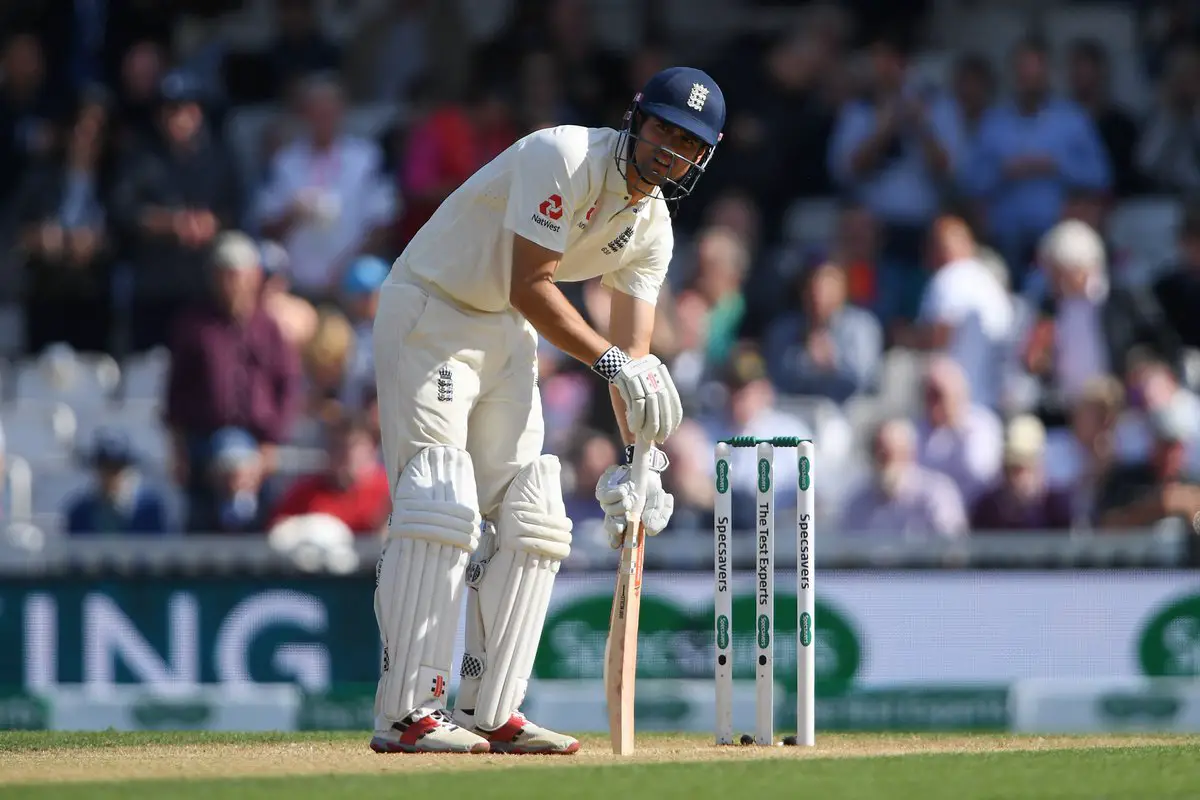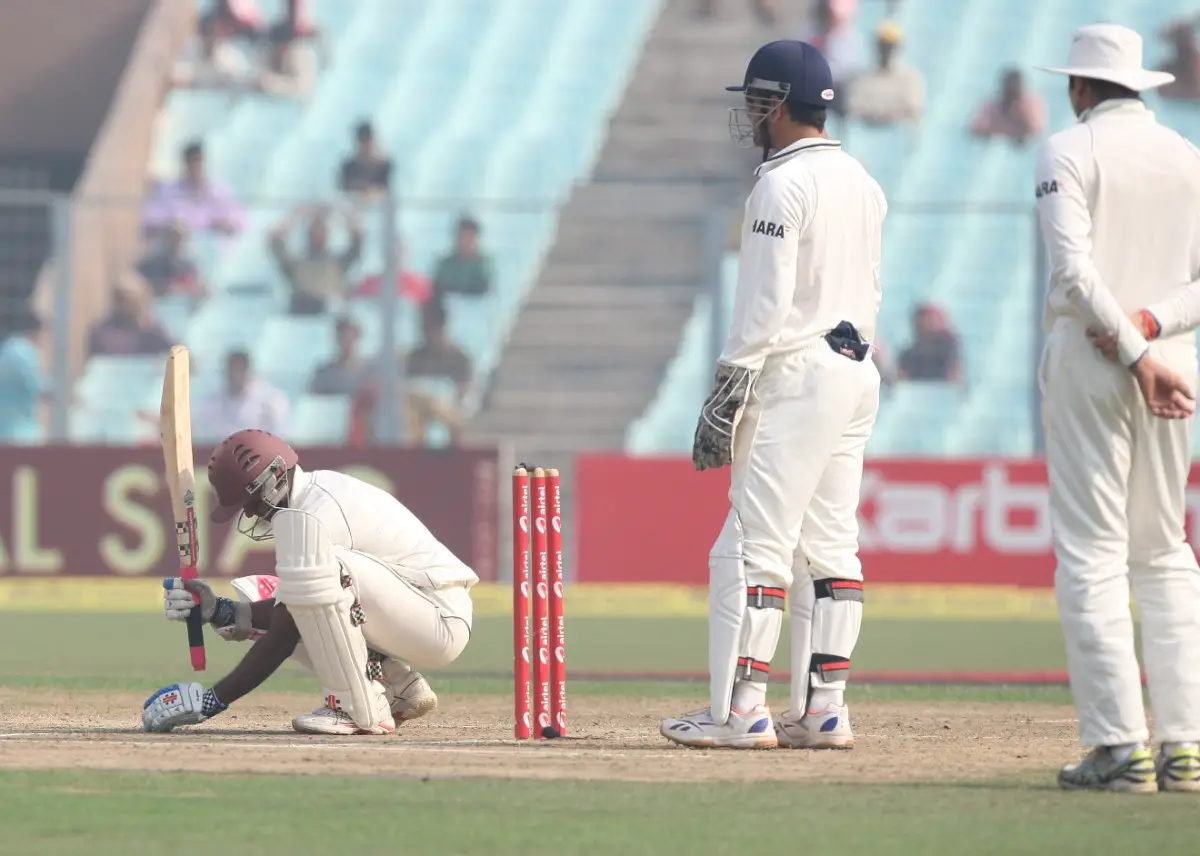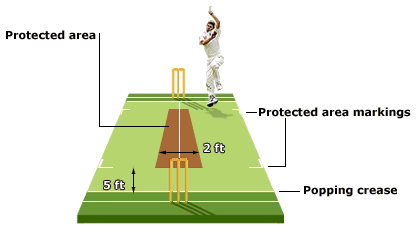Ever wondered why do players take so much time before facing their first ball? What do they signal to the umpires with fingers and then adjust their position accordingly? Are they just wasting time?
Well, the short answer to that question is that they are actually marking their guard! But, what does that mean and why do cricketers take guard?
Cricketers take guard to mark their position on the popping crease relative to the stumps so they can adjust their stance while batting. A batsman usually takes umpire’s help for taking guard. The common guard positions are leg, middle, and leg-middle. An easy way to mark the guard is using spikes of the shoe.
Taking guard allows the batsman in cricket to know exactly where his stumps are which gives confidence while batting! Despite this being one of the most primitive aspects of cricket, not a lot is said, written, and thus, known about it. In this post, we will unravel the concept of taking guard in cricket.
What is Taking Guard in Cricket?
Taking Guard in cricket is a method by which a batsman ascertains his position in the batting crease generally before getting ready to play the first ball. However, some players take guard after a break or intermittently anytime during the match.
Taking guard is one of the most important aspects of batting, especially before a batsman begins his innings since it gives him a sense of body and head position at the crease which is crucial to judge the line of the incoming delivery which, in turn, is essential to decide the balls to be played at or left alone.
Why is it necessary to Take Guard in Cricket?
Batsmen do not just practice hitting the ball in the nets but also concentrate on leaving the deliveries that may not yield any runs but could materialize in a dismissal. Most of such deliveries are around off stump. Knowing the position of the off stump is essential in batting and that is why taking a guard is necessary while playing cricket.
A batsman who is equally good at leaving the ball is rated highly especially in Test Cricket. That is why batsmen insist on standing in the same position during the practice so that the position of the off stump is etched in the mind’s eye.
When a batsman asks for a guard to the umpire during a match, he/she is essentially trying to get into the very same position so that the off stump is exactly where the mind’s eye thinks it is. That way the batsman could stop worrying about stumps and concentrate on the incoming delivery and decide, without hesitation, whether to play it or leave it.
Some batsmen prefer changing the guard based on the type of the bowlers, in such a guard should be taken as and when needed. More on this later.
How to take a Guard in Cricket? How to ask the Umpire for a Guard?
The principal thing about taking a guard is to know beforehand where do you want it. The umpire at the other end can help you adjust the position but he is not there to decide it for you. Thus, one of the important things that you need to do as a batsman is to indicate to the umpire what type of guard you intend to take.
Let’s go through the simple steps to follow while taking the guard:
Step 1 – Begin with the Leg Stump Guard

Wait before you come to the batting end. Then stand near, or a bit outside, the leg stump, and keep the bat upright at the position where you want to mark the guard. Remember to keep the face of the bat towards the boundary on the off side such that the umpire can only see the side part of your bat
Step 2 – Indicate the Guard needed to the Umpire
The next step is to signal or tell the umpire about guard you want – generally the guards are leg stump, middle-stump, and middle-and-leg stump.
- Adjust the position as per umpire’s suggestions until you get into the desired position.
- Then mark the guard appropriately. Generally, a guard is marked by scratching the desired area near the popping crease using shoe spikes or stump nails, etc.
Step 3 – Mark Your Guard on the Popping Crease
Once the guard is taken, it is important to mark the guard on the crease so that you don’t have to keep asking for the correct position of the stumps on your crease.

A guard can be marked on the popping crease by toes of the shoes, or by scrapping the surface using the toe of the bat. Some players like Shivnarine Chanderpaul of the West Indies had a unique way of using the bails to mark the guard on the pitch!
If you feel comfortable with the guard that you have taken, you should feel ready to face the next delivery! Don’t hesitate to change the guard if you find you haven’t got the perfect mark.
What are the Different Types of Guards and How to Ask for Them?
Although nothing stops batsmen across the world from taking weird and unconventional guards, there are mainly 3 different types of guards in cricket. Batsmen like Steven Smith or Shivnarine Chanderpaul do sometimes take unusual guards but these are very rare cases.
Let’s take at the 3 main types of guards and how to ask for them.
1. Leg Stump Guard (call out or signal with 1 finger)
The method of taking a leg-stump guard is to ask the umpire by calling out ‘leg stump’ or by signaling with ‘1’ with the finger. Generally, the batsmen who are predominantly off-side players tend to take this guard.
2. Middle Stump Guard
Batsmen who want middle stump guard call out ‘middle-stump’ or just say ‘center’ so that umpire understands that the ‘middle-stump’ guard is desired.
With middle-stump guard playing on both sides in front of the wicket – in the ‘V’ – become easier. Although, you may end up playing around the pads which increases the chance of an LBW dismissal.
3. Middle-and-leg Stump (call out or signal with 2 fingers)

A middle-and-leg stump guard asked for by calling it out or signaling with 2 fingers towards the umpire. As the name suggests the guard is exactly between middle and leg stump.
This guard is taken when you don’t want to commit too much to the leg-stump but wants to have the stance to facilitate off-side play as well as playing in the ‘V’.
What are the different ways of marking the guard? Are there any restrictions?

Using shoes is the primary and most used method for marking the guard on one the position is fixed. However, some players use bat or bails to mark it on the pitch. Although the choice of method is there when it comes to marking the guard there are certain restrictions about it.
As per Law 41 – Unfair play, the striker cannot mark the guard or take a stance in the protected area or so close to the protected area that frequent encroachment is inevitable.
NOTE: Protected Area is defined as an imaginary rectangle created by a set parallel lines about 5 feet from the popping crease at both ends and about 2 feet wide at the center on the pitch as shown below.
Do Batsmen Change Guard According to the Bowler?
Yes, the batsmen do change guard according to the bowler in Cricket. It has been observed that right-handed move the guard slightly towards the leg stump or open up their stance a bit to tackle the left-arm fast bowler coming over the wicket.
Also, it has been observed that batsmen move slightly towards the off-stump for tacking the spinners who spin the ball into the off-stump to have the contact outside the off-stump or move the guard slightly to the leg side to negate the spinners trying to spin them out around the legs.
Although, it advisable not to tinker with the batting guard so much because it may confound the understanding where the stumps are which is of prime importance for a batsman.
How does batsman’s guard affect the Wide-Ball decision?
As far as a wide ball is concerned, batsman’s original position matters as much as the moved one. A wide is very much subject to umpire’s interpretation. For a ball to be declared wide, it has to be unplayable, in umpire’s opinion, from the starting position – and moved position, if at all – of the batsman.
Umpires are very strict about wide-ball around leg stump, especially in limited-overs cricket. If you take a guard too much outside the leg stump to lure the bowler into bowling on the legside and then cheekily move towards the off stump to play and miss it, then the umpire is within his rights to not call it a wide-ball. Just something to remember when you are trying to be cheeky.
Final Thoughts
I hope this article has given you extensive insight into the field of taking guard in cricket. I’m sure some of you must have realized it more important than you thought it was. Anyhow, do think about perfecting your guard and stance the next time you enter the nets and do follow the same in the actual match. I’m sure you will be a much-improved cricketer.
